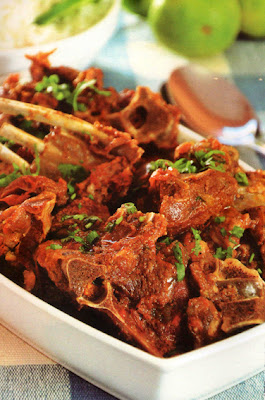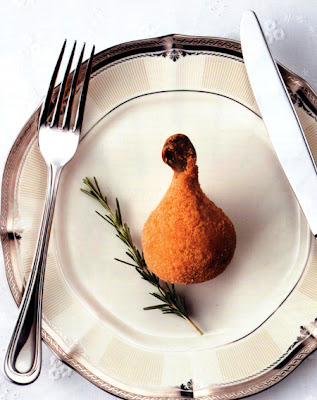On Monday, in a
post on
Flavors of Brazil about the Brazilian tripe-and-beans dish known as
dobradinha, I promised that on Wednesday (today) a typical recipe for that dish would be posted. And as far as this blog is concerned, a kept promise is the best kind, so here is the recipe.
Naturally, a dish that has a long and glorious history, like
dobradinha, will have countless varieties and variations. Some are regional and some are historical. The one thing about this multitude of recipes is that everyone thinks that their mother has the original (and best) recipe. A good
dobradina has to be exactly like
Mamãe (Mommy) made it all those years ago.
This recipe comes from the southeastern interior of Brazil, from the state of Minas Gerais. Minas was one of the earliest-settled parts of Brazil and is one of the parts of Brazil in which the influence of Portugal is strongly felt - from the food, to the music, and to the amazing Baroque architecture that graces its churches and relious buildings. Since
dobradinha is of Portuguese origin, it makes sense that Mineiro (from Minas Gerais)
dobradinha is considered among the best and most traditional.
One thing to note - this recipe calls for the use of a pressure cooker. Almost every Brazilian kitchen has a pressure cooker, and most Brazilian cooks use it daily. A kitchen without a pressure cooker here in Brazil would be like a 21st-century North American kitchen without a microwave - you can cook without one, but most choose not to. The recipe can be made successfully with a pressure cooker. Just allow for approximately double the cooking time for the various parts of the dish - beans, meats - and watch carefully to make sure that the dish doesn't become dried out. Just add a small amount of warm or hot water when that appears to be happening.
This dish is very hearty and substantial. Traditionally it is served with white rice,
Mineiro-style kale, and manioc flour (
farinha).
___________________________________________________
RECIPE - Dobradinha
Serves 8
2 cups dried white beans - Navy beans, cannellini beans or similar
2 lbs (1 kg) tripe
juice of 2 large limes
1/2 cup (125 ml)
cachaça
2 unpeeled limes, sliced
white or yellow cornmeal
4 medium tomatoes, peeled, seeded and chopped
1 green bell pepper, diced
1 medium onion, diced
Italian parsley and green onions (green part only), to taste
1/2 cup lard or neutral vegetable oil
8 cloves garlic, crushed
1/2 Tbsp. ground annatto (urucum) - sweet paprika may be substituted
1 clove garlic, peeled and pounded to a paste with 1 tsp. salt
2 bay leaves
---------------------------------------------------------------------------
Prepare the beans: Soak the beans overnight in plenty of cold water. Alternatively, put the beans in a large saucepan, cover with plenty of cold water, place on medium high heat on the stove and bring to a boil rapidly. Boil for one minute, then remove from the heat, cover the pan, and let stand for one hour. Once soaked or pre-boiled, put the beans in a heavy pan, cover with fresh water, bring to a boil over medium-high heat. Reduce the heat to low and let the beans slowly boil (just a few bubbles appearing at any time) for 40 minutes to 1 1/2 hours. Cooking time depends on size and age of beans, so begin checking beans after about 40 minutes. The beans are done when they are fully tender but not falling apart. Once cooked, remove the beans from the heat and reserve.
Prepare the tripe: Cut the tripe into small 2 inch squares. Put the squares in a large saucepan, cover with water, then add the lime juice and cachaca to the pan. Bring to a full boil and boil for five minutes. Remove from heat. Drain the tripe into a colander, rinse with plenty of running water and reserve. Wash the pan, then return the drained tripe to the pan and cover with fresh water. Again bring to a boil, cook for five minutes, then drain and reserve. Repeat the process a third time. After draining a final time, rub the tripe with the lime slices and cornmeal to clean it thoroughly and remove all dirt. Rinse under a thin stream of water, scrubbing the lime and cornmeal into the tripe as you rinse. (This process eliminates the strong odor of unwashed tripe and is essential to a successful dobradinha.)
Make the dobradinha: In a pressure cooker with the top off, melt the lard or add the vegetable oil. Then add these ingredients in order: garlic, onion, annatto or paprika, salt to taste, tomatoes green onion and bay leaf. Stir and cook over medium heat for a few minutes, or until the onion and pepper begins to soften. Add the tripe, mixing it in thoroughly until it begins to color from the annatto. Slowly add water - just enough to cover the ingredients by about one inch. Close the pressure cooker, and cook for approximately 30 to 40 minutes, or until the tripe is tender (If not using a pressure cooker, cook for 1 to 1 1/2 hours). When the tripe is tender, add in the beans, and cook, with the pressure cooker uncovered, for about 5 minutes, or until everything is heated through and the beans have been flavored by the tripe. Remove from heat.
Place in a decorative serving bowl, and sprinkly chopped parsley and green onion over the top. Serve immediately.
(Note: some recipes call for additional meats - sausages, pork ribs, or bacon. If adding these, put them in the pressure cooker at the same time as the tripe, and cook as directed above.)
Recipe translated and adapted from Cozinha Regional Brasileira by Abril Editora.



































